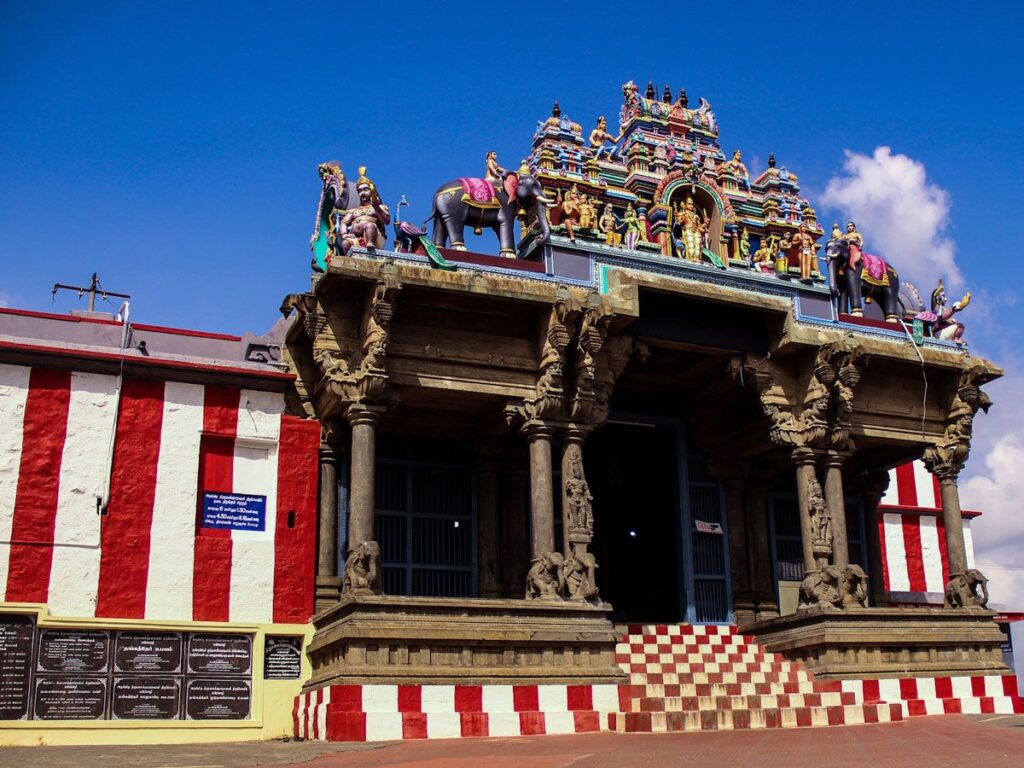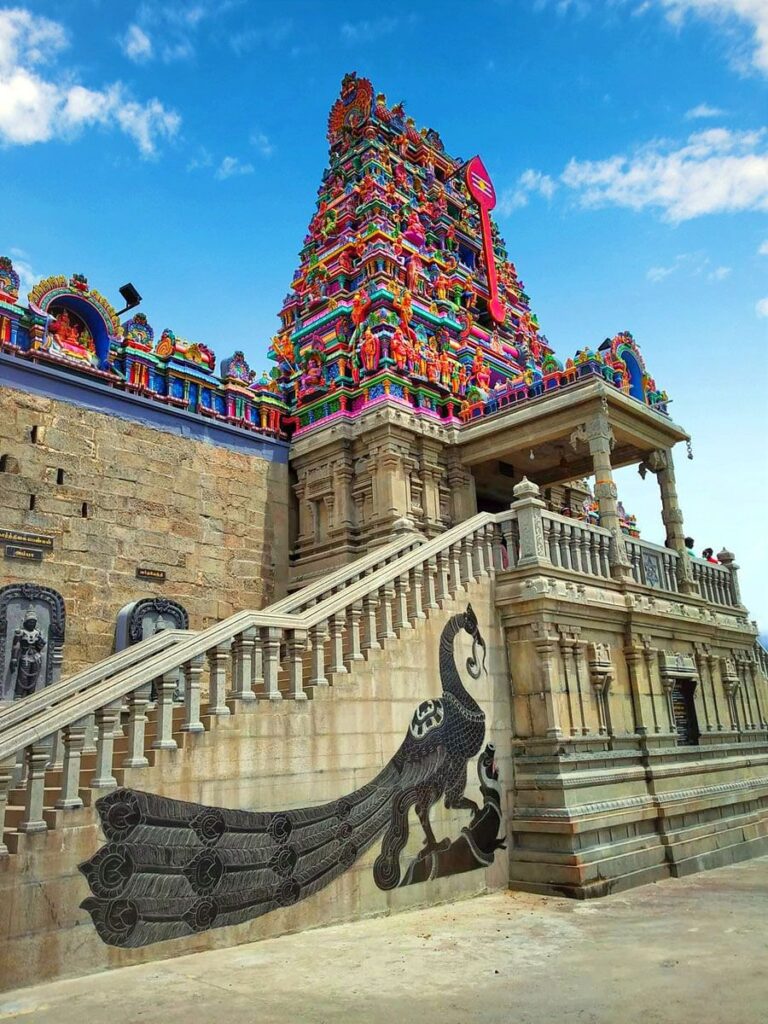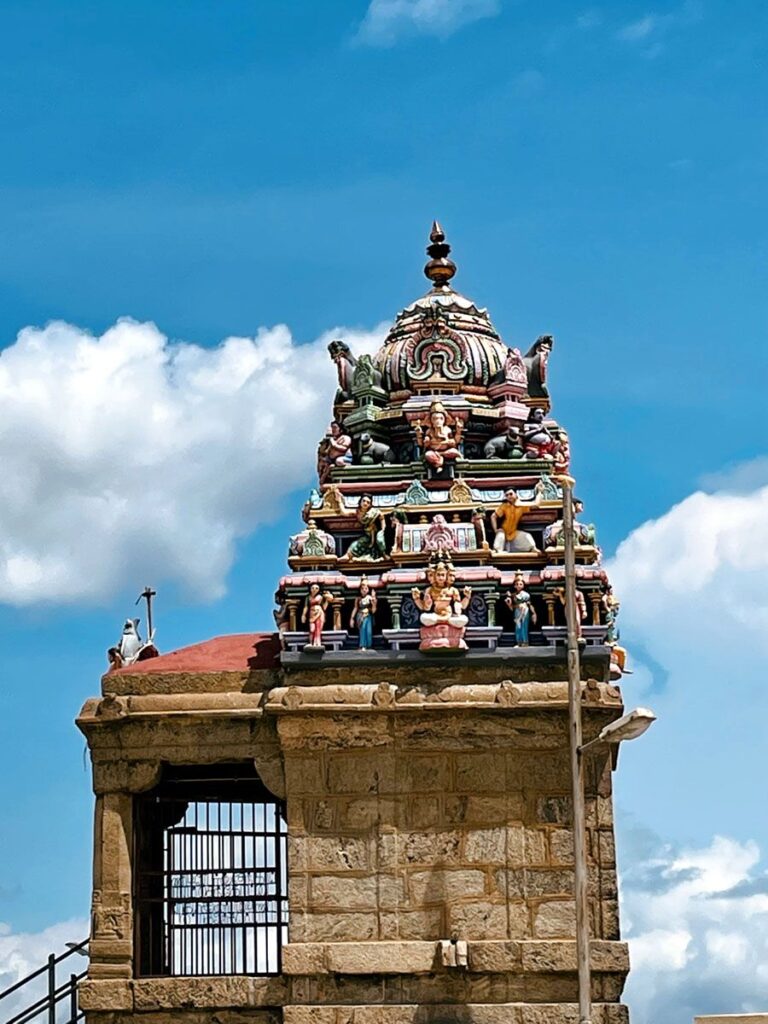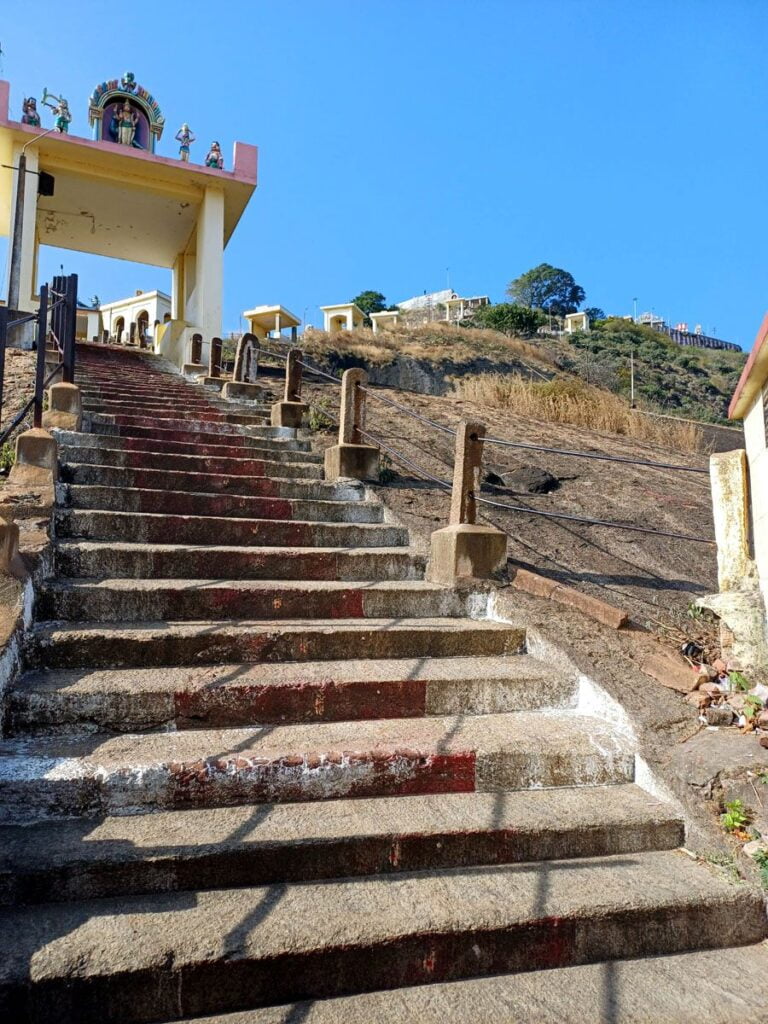Thirumalai Kumaraswamy Temple
The Thirumalai Kumaraswamy Temple, also known as Thirumalai Kovil, sits atop a small hill near Panpoli in the Tenkasi district of Tamil Nadu. Dedicated to Lord Murugan, the temple holds significance for its spiritual aura, historical background, and scenic location.

Contents
- 1 Thirumalai Kumaraswamy Temple History:
- 2 Legend of Thirumalai Kumaraswamy Temple:
- 3 Significance of Thirumalai Kumaraswamy Temple:
- 4 Myths of Thirumalai Kumaraswamy Temple:
- 5 Architecture of Thirumalai Kumaraswamy Temple:
- 6 Thirumalai Kumaraswamy Temple Timing and Rituals:
- 7 Places to visit near Thirumalai Kumaraswamy Temple:
- 8 FAQ:
- 9 How to reach Thirumalai Kumaraswamy Temple:
- 10 Google Maps:
Thirumalai Kumaraswamy Temple History:
Origin Story:
- Legends: The most popular legend tells of a priest named Poovan Patter who dreamt of Lord Murugan, who revealed his presence on the hill and instructed the priest to retrieve his idol from Kottaithiradu. Following the dream’s guidance, the idol was found and installed on the hill, forming the foundation of the temple. Other legends mention an existing Kali temple on the hill before the arrival of Lord Murugan.
- Historical estimates: While exact dates are unclear, historical references suggest the temple’s origins may date back to the 14th-15th centuries.
Literary Connections:
- Silapathikaram: This ancient Tamil epic mentions the hill as “Neduvelkundram” and suggests its association with Kannaki, the protagonist’s journey.
- Arunagirinathar: This renowned poet composed verses dedicated to Lord Murugan of Thirumalai, further solidifying the temple’s cultural significance.
- Other poets: Thandapani Swamigal and Kavirasa Pandarathiyar also praised the deity in their works, highlighting the temple’s literary importance.
Architectural Features:
- Hilltop location: The temple sits atop a small hill surrounded by the Western Ghats, offering scenic views and a sense of spiritual serenity.
- 624 steps: Devotees ascend these steps to reach the temple, adding to the pilgrimage experience.
- Main shrine: Lord Murugan, known as “Thirumalai Kumaraswamy” or “Thirumalai Murugan,” resides in the sanctum sanctorum.
- Other deities: The temple also houses a shrine dedicated to Goddess “Thirumalai Kaali Amman.”
Read More>> Thanumalayan Temple Suchindram

Legend of Thirumalai Kumaraswamy Temple:
The Divine Dream
Legend has it that the idol of Lord Murugan, enshrined in the temple, appeared in a dream to a priest named Poovan Battar Archagar. The Lord instructed him to locate the idol on a specific hill. Following the divine vision, Poovan Battar embarked on a quest and discovered the idol amidst the lush greenery of the hills.
The Miraculous Journey
Upon finding the idol, Poovan Battar faced the challenge of transporting it down the hill. Miraculously, a tiger appeared and offered its back, willingly carrying the idol to its designated spot where the temple now stands. This act of devotion by the tiger is a testament to the divine power of Lord Murugan.
The Blessings of Thirumalai Kumaraswamy
Devotees believe that Lord Murugan, also known as Thirumalai Kumaraswamy, in this temple bestows blessings upon those who seek his grace. He is said to remove obstacles, grant wishes, and bring prosperity and good health.
The 624 Steps to Enlightenment
Reaching the temple involves climbing 624 steps, symbolizing the spiritual journey towards enlightenment. Each step signifies a challenge or obstacle that must be overcome to reach the ultimate goal of inner peace and liberation.
The Festival of Skanda Sashti
The temple comes alive during the Skanda Sashti festival, a six-day celebration dedicated to Lord Murugan. Devotees undertake rigorous rituals, including fasting and prayers, to seek the Lord’s blessings. The vibrant processions and traditional music create a truly captivating atmosphere.
A Beacon of Hope and Faith
The Thirumalai Kumaraswamy Temple continues to be a beacon of hope and faith for millions of devotees. Its rich history, captivating legends, and serene atmosphere make it a place of spiritual significance and cultural importance.
Read More>> Arupadai veedu | Six Abodes of Lord Murugan

Significance of Thirumalai Kumaraswamy Temple:
Religious Significance:
- Dedicated to Lord Murugan: The temple enshrines Lord Murugan, a widely revered deity in Hinduism, particularly in South India. It serves as a major pilgrimage site for devotees seeking blessings and spiritual fulfillment.
- Nakshatra Temple for Vishaka Star: This temple is specifically associated with the Vishaka Nakshatra (birth star). People born under this star consider it their primary temple and visit for special prayers and rituals.
- Literary References: The temple finds mention in ancient Tamil literature like Silapathikaram and has been praised by renowned poets like Saint Arunagirinathar. This literary association enhances its spiritual aura.
Historical Significance:
- Ancient Origins: Though the exact date of construction remains unclear, archaeological evidence suggests the temple’s existence since at least the 8th century, making it a historical landmark.
- Royal Patronage: The temple received patronage from various rulers throughout history, contributing to its development and cultural significance.
- Legends and Folklore: Numerous legends and folk stories are associated with the temple, adding to its mystical appeal and cultural heritage.
Cultural Significance:
- Festivals and Traditions: The temple hosts vibrant festivals like Thaipoosam and Skanda Sashti, attracting large crowds and showcasing Tamil culture and traditions.
- Architectural Beauty: The temple boasts Dravidian architectural features, showcasing the region’s artistic heritage.
- Local Identity: The temple is deeply intertwined with the local community, serving as a center for social gatherings and cultural events.
Read More>> Brihadeeswarar Temple: Timeless Marvel of Chola Architecture

Myths of Thirumalai Kumaraswamy Temple:
The discovery of the idol: One myth narrates that the idol of Lord Kumaraswamy was not always housed in the current temple. A priest named Poovan Battar dreamt of the deity, who instructed him to find the idol hidden in a specific location. Guided by the dream, Poovan Battar discovered the idol and established the temple around it.
The connection to Agastya Muni: Another myth tells the story of Agastya Muni, a revered sage, who came to the Pothigai Hills (where the temple is located) seeking spiritual enlightenment. Lord Indra, concerned about his growing power, sent down heavy rains to disrupt his meditation. Lord Karthikeya (Kumaraswamy) intervened, protecting the sage by holding the rain clouds on his spear. This act is depicted in the temple’s architecture and iconography.
The blessings of the peacock: The temple is closely associated with peacocks, considered Lord Kumaraswamy’s vehicle. One myth claims that a devotee offered a peacock feather to the deity, which he readily accepted. This act pleased Lord Kumaraswamy, ensuring prosperity and good fortune for the devotee and the region.
The miraculous spring: The temple boasts a natural spring called Saravana Poigai, believed to possess healing powers. A myth recounts the story of a king suffering from leprosy who was cured after bathing in the spring’s holy waters. This miracle solidified the spring’s sacred status and continues to attract devotees seeking blessings and healing.
Read More>> Banapuriswarar Temple Kumbakonam

Architecture of Thirumalai Kumaraswamy Temple:
The temple architecture is believed to predate the 15th century, with a small number of inscriptions dating back to the 18th century. Here’s a breakdown of the key architectural elements:
Main Entrance:
- There are two entrances to the temple, each leading to separate enclosures.
- The main entrance is adorned with a three-tiered gopura, a gateway tower commonly found in South Indian temples.
Sanctum Sanctorum:
- The sanctum sanctorum, where the main idol of Lord Murugan resides, is oriented towards the east.
- In front of the shrine, there is a maha-mandapa, a large pillared hall, and a mukha-mandapa, a smaller antechamber.
Other Deities:
- A small idol of Ganesha, the elephant-headed god of wisdom and remover of obstacles, can be found near the main shrine.
- There is a shrine dedicated to Vallabha Vinayaka at the base of the hill and another Vinayaka shrine in the center of the path leading to the main temple.
Read More>> Kottaiyur Kodeeswarar Temple Kumbakonam
Thirumalai Kumaraswamy Temple Timing and Rituals:
Timings:
The temple is generally open from 5:30 AM to 8:30 PM. However, specific pooja timings may vary.
- General darshan: Most Murugan temples are open from sunrise to sunset. Specific timings may vary depending on the temple and the day of the week.
- Special pujas: Some temples may have special pujas (worship ceremonies) performed at specific times during the day. These timings are usually announced on the temple website or notice board.
Rituals:
- Abhishekam: This is a ritual bath performed on the idol of the deity using various sacred substances such as milk, curd, honey, and panchamritham (a mixture of five nectars).
- Deeparadhana: This is an offering of lamps to the deity.
- Archana: This is a chanting of mantras (sacred hymns) while offering flowers, incense, and other items to the deity.
- Prasad: This is sanctified food that is offered to the deity and then distributed to devotees.
Read More>> Rajagopalaswamy Temple Mannargudi: 10th CE Famous Dakshina Dvaraka
Places to visit near Thirumalai Kumaraswamy Temple:
- Rockfort Ucchi Pillayar Temple: Located atop a massive rock, this temple offers panoramic views of Trichy. It is dedicated to Lord Ganesha and is accessible through a series of steps carved into the rock.
- Sri Ranganatha Swamy Temple, Srirangam: One of the largest functioning Hindu temples in the world, this temple is located on an island in the Cauvery River. It is dedicated to Lord Ranganatha, a form of Lord Vishnu.
- Jambukeswarar Temple, Thiruvanaikaval: This temple is dedicated to Lord Shiva and is one of the Panchabhoota Sthalas, representing the element of water. The sanctum has a lingam submerged in water.
- Vekkaliamman Temple: Located near the Rockfort, this temple is dedicated to the goddess Vekkaliamman. It is known for its vibrant festivals and is a significant religious site in Trichy.
- Kallanai Dam (Grand Anicut): About 20 kilometers from Trichy, Kallanai is one of the oldest water-regulation structures in the world. It was built across the Kaveri River by the Chola king Karikalan.
- Government Museum: If you’re interested in history and art, the Government Museum in Trichy is worth a visit. It houses a collection of artifacts, sculptures, and exhibits related to the region’s history.
- St. Joseph’s Church: This is one of the oldest churches in Trichy, known for its architectural beauty. It is located near the Teppakulam Tank.
- Sri Ayyappan Temple: Situated on the banks of the Cauvery River, this temple dedicated to Lord Ayyappa is a peaceful and serene place for spiritual seekers.
FAQ:
General:
- What is the significance of the temple?
- The Thirumalai Kumaraswamy Temple is dedicated to Lord Murugan, a popular Hindu deity associated with war, victory, and wisdom. It is considered the nakshatra temple for people born under the Vishaka star.
- Where is the temple located?
- The temple is situated on a small hill in Panpoli, Sengottai district, Tamil Nadu, India, near the border with Kerala. It’s about 100 km from Thiruvananthapuram.
- How do I get to the temple?
- You can reach Panpoli by bus from Tenkasi or Shencottah. From there, you can either take a taxi or walk up the hill to the temple. A recent development includes a hill road for easier access.
- What are the temple timings?
- The temple is generally open from 5:30 AM to 8:30 PM. However, specific pooja timings may vary.
Worship and Practices:
- What is the main deity of the temple?
- Lord Murugan, also known as Thirumalai Kumaraswamy, is the main deity. He is depicted in a standing posture, holding a spear and shield.
- What are the special features of the temple?
- The temple is unique for its hilltop location, offering panoramic views. The hill itself is said to be in the shape of the sacred syllable “OM”.
- The temple also houses a shrine for Goddess Thirumalai Kaali Amman.
- What are the important festivals celebrated here?
- The temple celebrates various festivals throughout the year, including Thai Poosam, Kavadi Utsavam, and Iypasi.
- What are the poojas performed in the temple?
- Eight daily poojas are performed to Lord Murugan, each with specific rituals and offerings.
Additional Information:
- Is there accommodation available near the temple?
- Yes, limited accommodation options are available in Panpoli and nearby towns.
- What are the best times to visit the temple?
- The temple experiences a moderate crowd throughout the year. However, major festivals attract larger crowds. Pleasant weather conditions usually prevail from October to March, making it a favourable time to visit.
- Are there any specific guidelines or dress codes to follow?
- It is advisable to dress modestly and respectfully while visiting the temple. Removing footwear before entering the sanctum sanctorum is mandatory.
How to reach Thirumalai Kumaraswamy Temple:
By Air: The nearest airport is Madurai International Airport (IXM), which is well-connected to major cities in India. Once you reach the airport, you can hire a taxi or use other local transportation options to reach the temple.
By Train: Madurai Junction is the main railway station in Madurai and is well-connected to various cities in India. From the railway station, you can hire a taxi, auto-rickshaw, or use public transportation to reach the Thirumalai Kumaraswamy Temple.
By Road: Madurai has a well-developed road network, and you can reach the Thirumalai Kumaraswamy Temple by bus, taxi, or private vehicle. The temple is situated on the Thiruparankundram Road in Madurai.
